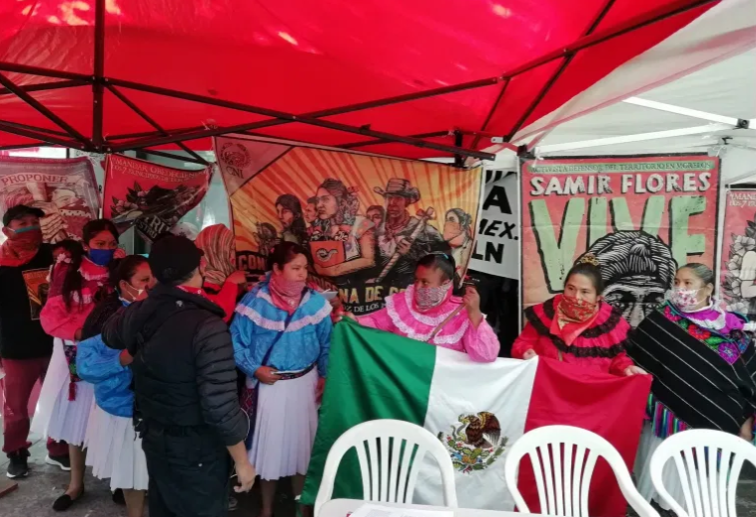
Photo: Colectivo Grieta
By Magdalena Gómez
A movement is underway that didn’t just begin this past October 12 with the decision of the community of indigenous Otomí residents of Mexico City to indefinitely occupy the headquarters of the National Institute of Indigenous Peoples (INPI). This movement must be analyzed in its different dimensions. The takeover is led by indigenous people from Santiago Mexquititlán, in the municipality of Amealco, Querétaro, who have lived in Mexico City for more than 20 years. Since then, they have fought for their right to access decent housing, they have visited government offices, and they have gone through the protocols, without results. They have lived overcrowded, without basic services in four abandoned properties in the streets of Zacatecas 74 and Guanajuato 200, Colonia Roma; Avenida Zaragoza 1434, por Pantitlán, and Roma 18, en la Juárez. The latter had been abandoned since the 1985 earthquakes, but the one in 2017 made it unlivable and it forced them to camp in the street; and last year they were evicted by the public forces without the promise of regularizing their situation.
This is where we situate the local scope of the problem. However, for the last four years ago they have been connected to National Indigenous Congress (CNI) and the Indigenous Governing Council (CIG), to the demands of the peoples for their collective rights. This is why they call their courageous decision “Occupation for the dignity of our people.” They added: This is the time to raise our voices, not to remain silent. For 528 years they have oppressed us, taken from us, as if to leave us 528 more years, stated Maricela Mejía councilwoman of the CIG, backed by her female comrades. As a matter of principle, they affirmed that the INPI does not represent them, nor did it under its previous acronym, but now the building will truly be their home. As such, they proceeded to occupy two of the six floors, and to paper them with banners and posters of the Zapatista Army of National Liberation (EZLN). On October 17th, in the INPI facilities, the Otomí community held a forum: At 528 years: Our little light of resistance and rebellion continues burning, with the participation of spokeswoman of the Indigenous Governing Council, María de Jesús Patricio (Marichuy), who supported the action of the Otomí community in Mexico City. She told them: We are going to continue, because you all have a very important tool, which is your voice. We may not have weapons, but our weapon is our voice, and we do not have to remain silent. You are part of a national indigenous movement. In their press conferences the Otomí include questioning of the ongoing megaproyectos, they demand that real consultations with indigenous communities be held, and they express their opposition to the Mayan Train, the Morelos Integral Project, that includes the thermoelectric plant, and the Interoceanic Corridor in the Isthmus of Tehuantepec.
People and organizations of the CNI and the National Indigenous Network (RNI) have joined them in their demands and expressed support, in contrast with other indigenous groups who deem it necessary to close ranks with the director of INPI, allegedly aggrieved by the occupation of its offices.
It is interesting to observe how the Government of Mexico City, directly responsible for the long-standing lack of attention to the Otomí community has mimicked itself in the INPI, which boasts the representation of the government of Mexico, in its official communications. To date, the position is not known. Yes, it appears the Secretariat of Government of the CDMX and the Commission on Human Rights of the CDMX are referred to as a mediating institution (communiqué 15/10/20). Certainly the Otomi community will be analyzing the proposal to participate in a work forum that will raise its doubts, because after years of expressing your demands and carrying out official procedures, now they invite you to dialogue to learn about your needs and requests and to advance in the attention to them. The president of the Human Rights Commission of Mexico City, Nashieli Ramírez, attended the meeting and respectfully offered to mediate a dialogue, as well as to follow up on the fulfillment of the agreements that are reached, awaiting their response.
The “enough is enough” of the Otomí community has put up a mirror to the ongoing neo-indigenism; for the moment, the evidence that individual support programs and scholarships are not enough, as long as structural issues of the indigenous communities with respect to self-determination and autonomy are not addressed. This movement is growing with the national agenda, as the so-called 4T (AMLO’s administration) adds new grievances to the previous ones. It is unthinkable that the government might propose, and the CNI-CIG, without the EZLN, would accept a dialogue that produces a new version of the unmet agreements of San Andrés. The coin is in the air. It is uncertain, to begin with, if it will address the housing of Otomí residents in Mexico City.
This article was originally published in Spanish in La Jornada on October 27th, 2020. https://www.jornada.com.mx/2020/10/27/opinion/020a2pol This English interpretation has been re-published by Schools for Chiapas.
